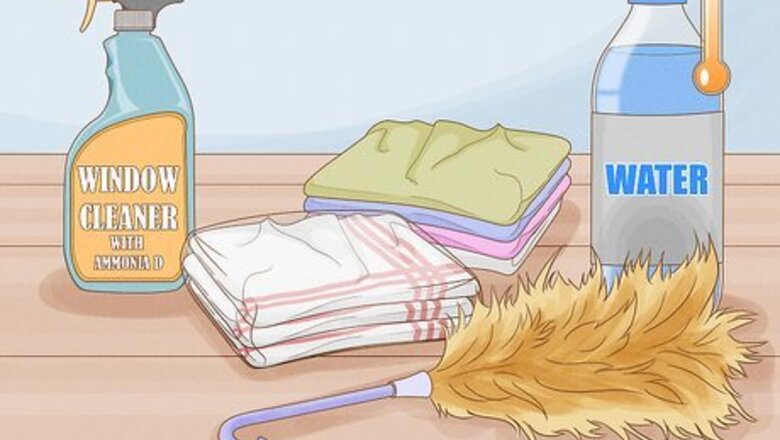
views
- To clean dusty plastic plants, wipe down them down with a dry microfiber cloth.
- For silk plants, fill a spray bottle with equal parts water and vinegar. Spray the foliage with the mixture before drying it off with a clean microfiber towel.
- For plastic aquatic plants, rinse the leaves with hot water. Then, soak them in a water-bleach mixture for 1 hour before rinsing them a final time.
Cleaning Plastic Plants

Gather your cleaning products and tools. In order to thoroughly rid your plastic plants of dirt and dust, you will need to have the following cleaning products and tools on hand: Feather duster, vacuum cleaner, or paintbrush Microfiber cloths Cleaning rags Hot water Window cleaner with Ammonia D

Dust your plants. Begin the cleaning process by removing dust, dirt, and debris from your plastic plants. There are several ways to remove dust from your plastic plants: Run over your faux foliage with a feather duster. Take the plant outside and use a paintbrush to sweep off the excess dust. Attach a cleaning brush to your vacuum and suck up the dust, dirt, and debris. Wipe down the leaves, stems, and pot with a dry microfiber cloth or a wet rag. Submerge your plastic plants in hot water or spray them down with a hose.

Dry your plastic plant. After dusting your plastic plant, dry the leaves, stems, and pot. You may allow the plant to air dry or wipe it down with a clean, dry cloth. If you submerged your plant or rinsed it with water, this step is especially important.

Spray window cleaner with Ammonia D on your plant. To thoroughly clean your plastic plant, you must dust as well as disinfect it. Spray window cleaner with Ammonia D onto your entire plastic plant. Set your plastic plants in the sunlight for 30 minutes. This will help activate the cleaning product and restore your plastic plant’s vibrant colors.
Cleaning Silk Plants
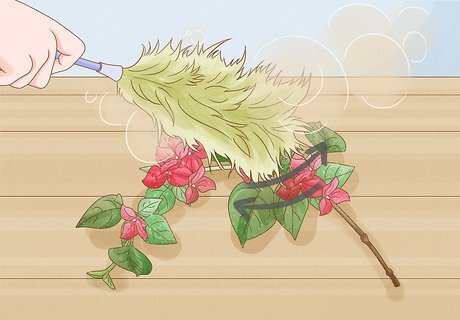
Dust your silk plants. When your silk plants have accumulated small amounts of dust and dirt, rely on traditional dusting methods to efficiently clean and revive your faux foliage. There are several dusting methods to choose from: Run over the leaves, flowers, stems, and pot with a feather duster. Attach a cleaning brush to your vacuum and suck up the dirt, dust, and debris. Remove dust from your plants with a blow dryer set to low heat. Wipe away grime from your silk plants with a dry microfiber cloth.
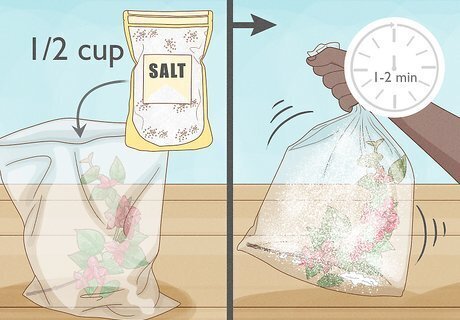
’Dry Clean’ hard to reach dust with salt. Remove moderate dust accumulation from all the nooks and crannies of your silk plants with a simple, yet effective, salt-cleaning method. Pour ½ cup salt into a plastic bag—the size of the bag is dependent upon the size of your silk floral arrangement. Place the silk floral arrangement inside the plastic bag and seal it shut. Shake the bag vigorously for 1 to 2 minutes. The salt will act as scrubbers, removing dust, dirt, and debris from the surface and hard to reach places. Repeat the process as needed. Open the bag. Turn the silk arrangement upside down with in the bag and shake it once or twice to remove the salt. Remove the arrangement from the bag and return it to its container. You may substitute cornmeal or rice for salt.
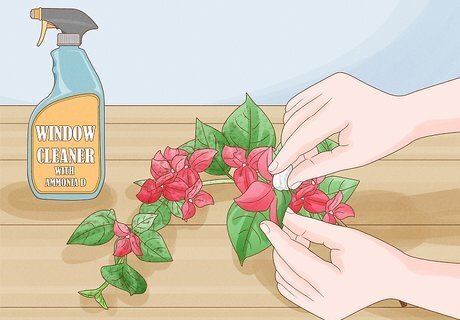
Check for colorfastness before liberally applying any cleaning product or water. When checking for colorfastness, you are trying to determine how resistant the dye in a fabric is to removal. Prior to applying large amounts of water or a cleaning product to your silk flowers, always test an inconspicuous spot to see how it affects the color. Spray, dab, or wipe a minuscule amount of cleaning product onto an inconspicuous part of the silk flowers and observe the spot for changes. If the color was negatively affected, do not proceed to use the product; If the color did not change, the product is safe to use.

Remove grime with cleaning products. When your silk foliage is coated in grime, revive your faux bouquets with various cleaning products. Before applying these products, place your arrangement in a sink or outdoors. Refresh your faux foliage with a silk flower cleaner, which come in spray and aerosol varieties. Coat the entire arrangement with the silk flower cleaner. Follow the instructions provided on the product. Fill a spray bottle with 50/50 water and white vinegar mixture. Spray the entire arrangement with the water-vinegar mixture—don’t forget to spritz the backside of leaves and petals. Dab the arrangement dry with a clean cloth. You may substitute rubbing alcohol for white vinegar. In a clean 3-gallon bucket, combine 2 gallons of hot water with 1 tablespoon of white flaky soap. Fill a spray bottle with this mixture. Coat the entire arrangement with the water-soap mixture. Dry the arrangement with a clean cloth. If your silk flowers require additional cleaning, you may then apply 1 to 3 coats of non-aerosol silk flower cleaner to your arrangement—allow the silk flowers to dry completely between coats.

Rinse your arrangement in cool water. Easily remove a thick coating of dust from your silk arrangements with cool water and dish soap. Fill a small basin with cool water—never use hot water, it will melt the glue used to hold the flowers together. Squirt a small amount of dish soap into the water and mix. Dip one stem at a time into the cool, soapy water flower first. If necessary, rub the foliage lightly to remove grime. Remove the stem from the water a blot dry with a clean cloth. Repeat on the remaining stems. Once clean and dry, rearrange the flowers and return them to their container.
Cleaning Fake Aquatic Plants

Run your plastic plants under hot water. Over time, algae builds up on the surface of your plastic aquatic plants. Before you can sterilize the fake plants, you must remove the algae. Turn on your faucet and wait for the water to become hot. Place the plastic plants under the running hot water to rinse off the algae.
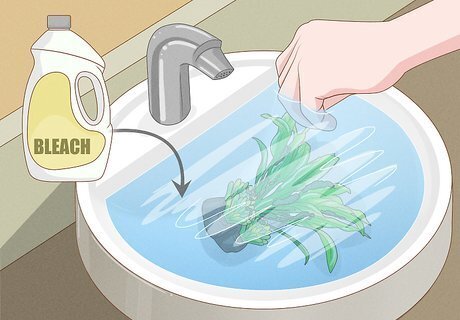
Submerge your plastic plants in a water-bleach mixture. The process of sterilizing your plastic aquatic plants in a water-bleach mixture begins by submerging them in a water-bleach bath for 1 hour. Retrieve a 3 gallon bucket, disposable plastic gloves, protective eyewear, and a bottle of bleach. Pour 1 gallon of hot water into the bucket. Put on the disposable gloves and protective eyewear. Add 1 teaspoon of bleach to the water and stir. If your plants are vividly colored, add an addition ½ teaspoon bleach. Submerge the faux foliage into the water-bleach mixture for 1 hour. Stir the mixture every 15 minutes.

Cleanse the plants with a chlorine neutralizer. Before returning your plastic plants to an aquarium, soak them in a chlorine neutralizer and rinse with hot water. Retrieve a clean 3-gallon bucket. Pour 1 gallon of hot water into the fresh bucket. Submerge the plants in the water. Add a chlorine neutralizer to the water—carefully follow the instructions on the package. After the allotted soaking time, remove the plants from the bucket and rinse your faux plants under hot water.
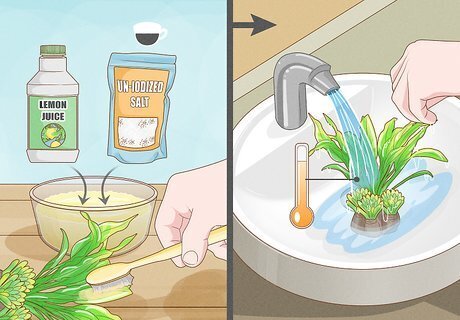
Rinse and scrub your silk plants. You must clean your silk aquatic plants differently than your plastic aquatic plants—exposing your silk plants to bleach will damage the fragile fabric. Rinse your silk plants under hot tap water to remove any built-up algae. Create a cleaning paste. Measure out ½ cup un-iodized salt and pour it into a small bowl. Gradually add lemon juice until a paste is created. Apply the paste to the silk plants with a clean toothbrush. Scrub thoroughly. Rinse the silk plant under hot water to remove the paste and any remaining algae.




















Comments
0 comment